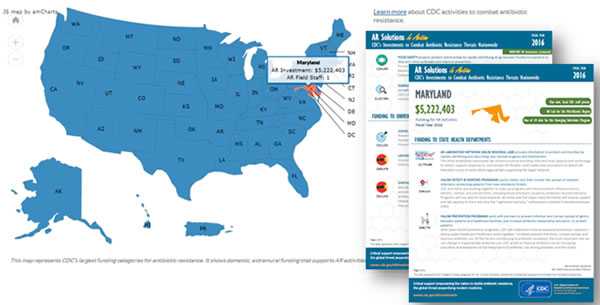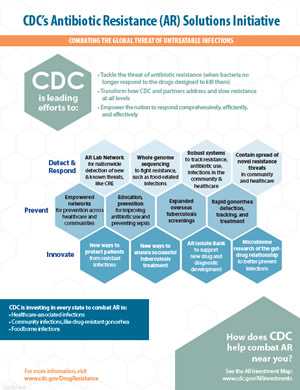Overview of Key Investments
CDC’s strategic investments empower the nation to combat AR and the threat it brings to people, modern medicine, and to the healthcare, veterinary, and agriculture industries. These investments work toward meeting national goals to prevent drug-resistant infections.
Learn about CDC’s 2016 state activities to combat AR: Use the AR Investment Map for information on CDC’s key AR activities by state.

With these investments, the CDC, in partnership with health departments, academia, and healthcare, is transforming how the nation combats and slows antibiotic resistance at all levels, ensuring our ability to stand up a full, faster response to protect Americans from this threat. These investments will better protect patients through:
Detection and Response
- Rapid detection and faster response to outbreaks and emerging resistance related to healthcare-associated infections, foodborne bacteria, and gonorrhea—to contain and control spread
- Gold-standard lab capacity offered to all state and regional labs through CDC’s Antibiotic Resistance Laboratory Network
- Expanded overseas tuberculosis (TB) screenings and a national drug stockpile to prevent shortages of medicine needed to treat TB.
Prevention of Infections
- Improve prevention of healthcare-associated infections, foodborne illness, and gonorrhea
- Empowered networks for prevention across healthcare and communities for threats like Clostridium difficile, methicillin-resistant Staphylococcus aureus (MRSA), and “nightmare bacteria” carbapenem-resistant Enterobacteriaceae (CRE)
- Insights for research innovation and better patient care
Improving Antibiotic Use
- Ensure antibiotics work to protect patients from life-threatening infections or sepsis
- Protect patients from unintended consequences associated with antibiotic use, including adverse drug events
View CDC’s fact sheets by topic for more information on how AR Solutions Initiative activities provide critical support to combat antibiotic-resistant bacteria.
- Page last reviewed: July 19, 2017
- Page last updated: July 19, 2017
- Content source:


 ShareCompartir
ShareCompartir
